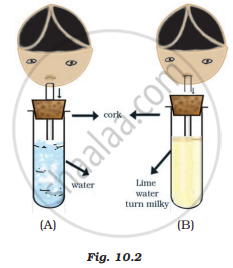Advertisements
Advertisements
प्रश्न
When a person breathes in the air, the air enters into his body through an organ A having two holes B in it. The air then passes through the pharynx and larynx and enters into tube C. The tube C divides into two smaller tubes D at its lower end. The two smaller tubes are attached to two respiratory organs E. Each smaller tube divides inside the organs E to form a large number of still smaller tubes called F. The smallest tubes F have air-sacs G at their ends in which gaseous exchange takes place in the body of the person. What are A, B, C, D, E, F, and G?
उत्तर
Here, A, B, C, D, E, F and G refer to the nose, nostrils, trachea, bronchi, lungs, bronchioles and alveoli, respectively.
APPEARS IN
संबंधित प्रश्न
Cellular respiration takes place in
(a) Lysosome
(b) Chlorophyll
(c) Mitochondria
(d) Ribosome
How are oxygen and carbon dioxide transported in human beings?
Name an animal which depends on simple diffusion of gases for breathing.
Name the red pigment which carries oxygen in blood.
Fill in the Following Blank with Suitable Word.
_________ In the Lungs Provide a Very Large Surface Area for Gaseous Exchange.
Explain why, it is dangerous to inhale air containing carbon monoxide.
During respiration, the exchange of gases takes place in:
The breathing and respiration in woody stem of a plant takes place through:
Answer the following in detail.
How is the process of cellular respiration different from breathing?
Answer the following in detail.
Explain the process of Cellular Respiration.
Name the body structure concerned with the given functional activity:
Provides actual diffusion of respiratory gases in the lungs.
Differentiate between the following pairs on the basis of the aspect given in the brackets.
Tidal volume and Residual volume (Quantity of air)
Respiration refers to ____________.
The major fraction of CO2 released during cellular respiration is transported by the blood to the lung capillaries ______
What is the ppCO2 in alveolar air?
Name the substances whose build-up in the muscles during vigorous physical exercise may cause cramps?
The Figure shown below represents an activity to prove the requirements for photosynthesis. During this activity, two healthy potted plants were kept in the dark for 72 hours. After 72 hours, KOH is kept in the watch glass in setup X and not in setup Y. Both these setups are air tight and have been kept in light for 6 hours. Then, Iodine Test is performed with one leaf from each of the two plants X and Y.

The function of KOH is to absorb ______.
Observe Figure 10.2 carefully and answer the following questions.

- Which process is being tested in the activity?
- What is the result of the activity? Give reasons.
With the reference to four gases CO2, CO, Cl2 and O2, which one of the options in the table is correct?
The oxygen dissociation curve is a sigmoid curve and it shifts towards the right due to ______.
